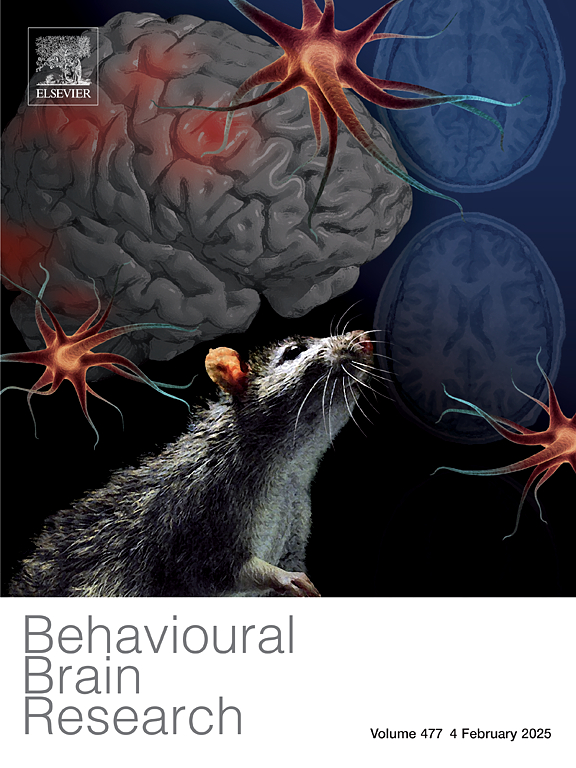槲皮素对帕金森病大鼠运动障碍和焦虑样行为的神经保护作用
IF 2.6
3区 心理学
Q2 BEHAVIORAL SCIENCES
引用次数: 0
摘要
帕金森病(PD)是一种进行性神经退行性疾病,其特征是运动障碍,如运动迟缓和僵硬,以及非运动缺陷,包括焦虑。这些现象与黑质多巴胺能神经元退化引起的氧化应激(OS)和线粒体功能障碍等潜在病理过程密切相关。最近的研究表明,像槲皮素这样的类黄酮通过抗氧化和抗炎的特性具有神经保护作用。在这项研究中,我们旨在评估槲皮素对6-羟多巴胺(6-OHDA)诱导的帕金森大鼠模型的运动功能、焦虑样行为和海马齿状回组织白介素-6 (IL-6)水平的影响,并观察两种剂量(10和25 mg/kg)槲皮素对行为的影响。将40只雄性Wistar大鼠分为5组:对照组、假手术组、帕金森组和2个槲皮素处理组(10和25 mg/kg),其中3个组在左内侧前脑束(MFB)注射6-OHDA(8 μg/3 μl)诱导PD。行为评估评估运动功能和焦虑样行为,包括阿帕吗啡诱导的旋转、旋转棒、钢丝悬挂、高架加迷宫和野外测试。我们的研究结果表明,槲皮素处理显著减少阿吗啡诱导的旋转,支持旋转杆和吊丝试验的结果,改善运动协调,其中25 mg/kg剂量效果更好。槲皮素还以剂量依赖的方式减轻了焦虑样行为,这是基于升高迷宫和开阔场地试验的结果。此外,结果显示PD大鼠海马IL-6水平较对照组显著升高,槲皮素治疗可降低其水平,但仍高于假手术组和对照组。这些发现表明槲皮素可以改善6-OHDA大鼠帕金森病模型的运动和焦虑样缺陷,可能通过调节海马神经炎症,突出了其作为帕金森病多靶点治疗剂的前景。本文章由计算机程序翻译,如有差异,请以英文原文为准。
Neuroprotective effects of quercetin on motor impairments and anxiety-like behaviors in a rat model of Parkinson’s disease
Parkinson's disease (PD) is a progressive neurodegenerative disorder characterized by motor impairments such as bradykinesia and rigidity, and non-motor deficits including anxiety. These phenomena are closely associated with underlying pathological processes including oxidative stress(OS) and mitochondrial dysfunction that arise from the degeneration of dopaminergic neurons in the substantia nigra. Recent studies have shown that flavonoids like quercetin have neuroprotective effects through antioxidant and anti-inflammatory properties. In this study, we aimed to evaluate the impact of quercetin on motor function, anxiety-like behaviors, and Interleukin-6 (IL-6) levels in hippocampal dentate gyrus tissue in a rat model of PD induced by 6-hydroxydopamine (6-OHDA) and examine the behavioral findings with the use of two doses (10 and 25 mg/kg) of quercetin. Forty male Wistar rats were divided into five groups: control, sham, Parkinson's, and two quercetin-treated PD groups (10 and 25 mg/kg), and 6-OHDA (8 μg/3 μl) was injected into the left medial forebrain bundle (MFB) in three of them to induce PD. The behavioral assessments evaluated motor function and anxiety-like behaviors, including apomorphine-induced rotation, rotarod, wire hanging, elevated plus maze, and open field tests. Our results indicate that quercetin treatment significantly reduced apomorphine-induced rotations, supporting the results of rotarod and wire hanging tests, improved motor coordination, with the 25 mg/kg dose showing greater efficacy. Quercetin also alleviated anxiety-like behaviors in a dose-dependent manner based on the results of the elevated plus maze and open field tests. In addition, the results showed a significant elevation of IL-6 in the hippocampus of PD rats compared to the control group, and quercetin treatment can reduce its levels, though the levels remained higher than in the sham and control groups. These findings suggest that quercetin ameliorates both motor and anxiety-like deficits in a 6-OHDA rat model of Parkinson’s disease, potentially through modulation of hippocampal neuro-inflammation, highlighting its promise as a multi-target therapeutic agent in PD.
求助全文
通过发布文献求助,成功后即可免费获取论文全文。
去求助
来源期刊

Behavioural Brain Research
医学-行为科学
CiteScore
5.60
自引率
0.00%
发文量
383
审稿时长
61 days
期刊介绍:
Behavioural Brain Research is an international, interdisciplinary journal dedicated to the publication of articles in the field of behavioural neuroscience, broadly defined. Contributions from the entire range of disciplines that comprise the neurosciences, behavioural sciences or cognitive sciences are appropriate, as long as the goal is to delineate the neural mechanisms underlying behaviour. Thus, studies may range from neurophysiological, neuroanatomical, neurochemical or neuropharmacological analysis of brain-behaviour relations, including the use of molecular genetic or behavioural genetic approaches, to studies that involve the use of brain imaging techniques, to neuroethological studies. Reports of original research, of major methodological advances, or of novel conceptual approaches are all encouraged. The journal will also consider critical reviews on selected topics.
 求助内容:
求助内容: 应助结果提醒方式:
应助结果提醒方式:


